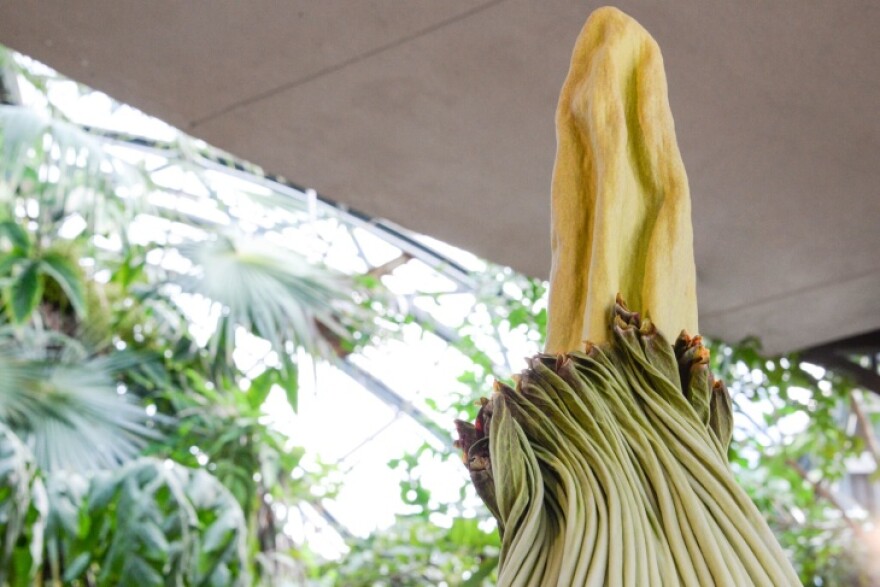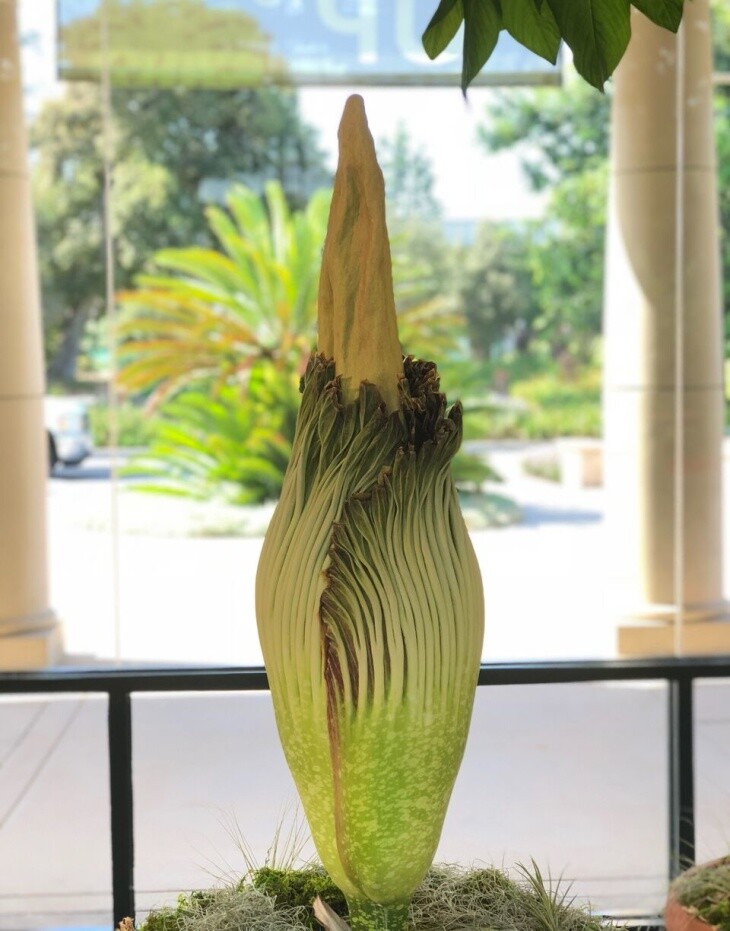With our free press under threat and federal funding for public media gone, your support matters more than ever. Help keep the LAist newsroom strong, become a monthly member or increase your support today.
Here Comes Li'l Stinker, The Corpse Flower About To Bloom At The Huntington

Get your noses ready.
The "corpse flower" at the Huntington Library botanical garden in San Marino is on the verge of blooming within the next few days. No one knows exactly when, because the plant has a mind of its own.
The corpse flower, also known as Amorphophallus Titanum, is not a flower for funerals, nor is it really a flower. It's the world's biggest flower stalk (or "unbranched inflorescence" in plant-speak), and its name refers to the smell emitted when it blooms, which happens every four to six years. The Huntington has 45 of the 4-foot-tall plants.
The signs pointing to the bloom? Li'l Stinker, as the plant is affectionately called around the Huntington, is more plump than usual, and its height growth has slowed. According to Huntington botanist Brandon Tam, the plant blooms aftergrowth has peaked and then stopped -- and the death flower just did that.

The bloom is not only rare, but really short-lived. It takes an enormous amount of energy to open up, so the bloom will only last a few days. This one is expected to be open for a maximum of 36 hours. Thirty-six very stinky hours.
But that brevity works just well for our smelly friend: the corpse smell attracts all kinds of pollinators and bugs at night, and the chances for successful pollination are very high.
Li'l Stinker is confident -- it knows that it attracts what it needs, and only does the work for about two days. Tam says it "doesn't feel the need" to bloom for longer.

When the corpse flower isn't growing, swelling or blooming, it's dormant, which makes it a relatively low-maintenance plant for the botanical crew. For three to five months, it'll just store up its own energy up, slowly putting up a leaf for photosynthesis. (Keep in mind: this plant is the biggest of its kind, and growing something that big takes a lot of energy.) Once it's stored enough, it'll bloom.
This will be the Huntington's sixth corpse flower bloom. Other Amorphophallus Titanums bloomed there in 1999, 2002, 2009, 2010 and 2014.
You can see -- and smell -- the bloom for yourself. It will be on display when it blooms in the Rose Hills Foundation Conservatory for Botanical Science of the Huntington, with no extra charge.
At LAist, we believe in journalism without censorship and the right of a free press to speak truth to those in power. Our hard-hitting watchdog reporting on local government, climate, and the ongoing housing and homelessness crisis is trustworthy, independent and freely accessible to everyone thanks to the support of readers like you.
But the game has changed: Congress voted to eliminate funding for public media across the country. Here at LAist that means a loss of $1.7 million in our budget every year. We want to assure you that despite growing threats to free press and free speech, LAist will remain a voice you know and trust. Speaking frankly, the amount of reader support we receive will help determine how strong of a newsroom we are going forward to cover the important news in our community.
We’re asking you to stand up for independent reporting that will not be silenced. With more individuals like you supporting this public service, we can continue to provide essential coverage for Southern Californians that you can’t find anywhere else. Become a monthly member today to help sustain this mission.
Thank you for your generous support and belief in the value of independent news.

-
What do stairs have to do with California’s housing crisis? More than you might think, says this Culver City councilmember.
-
Yes, it's controversial, but let me explain.
-
Doctors say administrator directives allow immigration agents to interfere in medical decisions and compromise medical care.
-
The Palisades Fire erupted on Jan. 7 and went on to kill 12 people and destroy more than 6,800 homes and buildings.
-
People moving to Los Angeles are regularly baffled by the region’s refrigerator-less apartments. They’ll soon be a thing of the past.
-
Experts say students shouldn't readily forgo federal aid. But a California-only program may be a good alternative in some cases.







